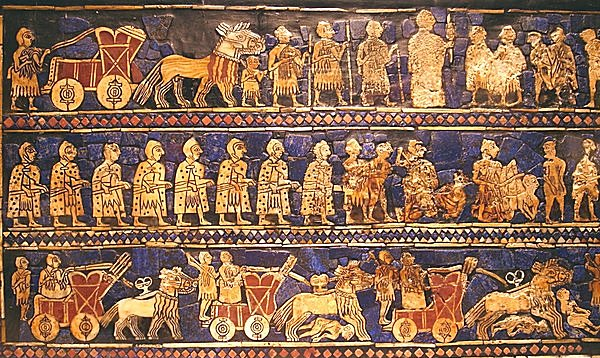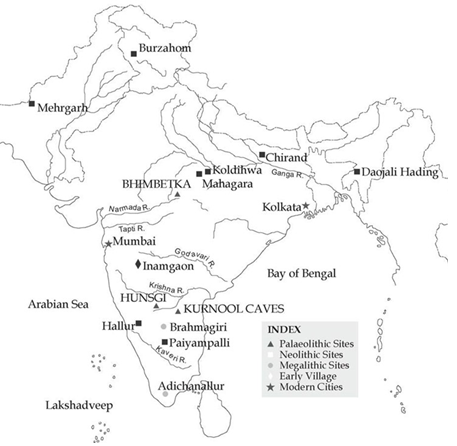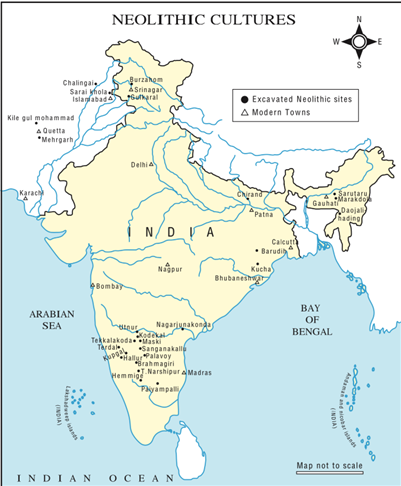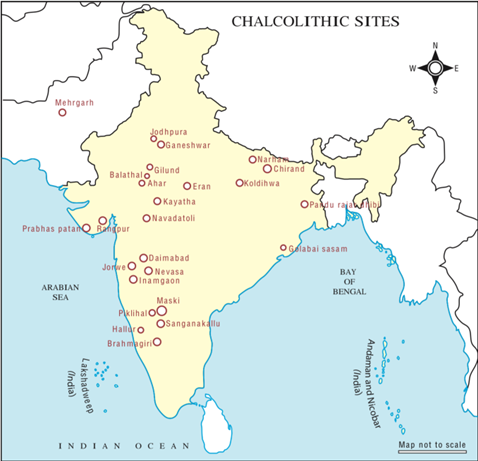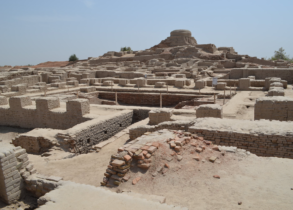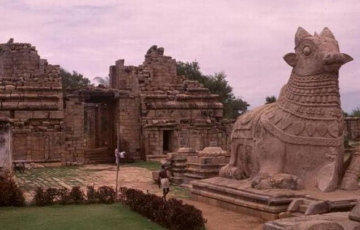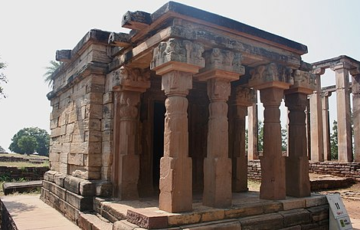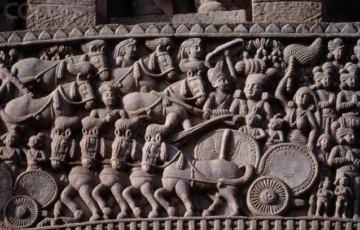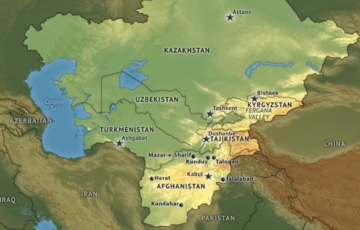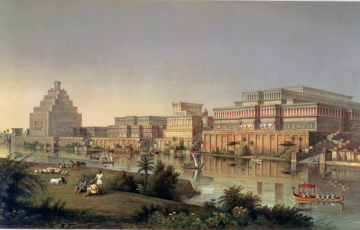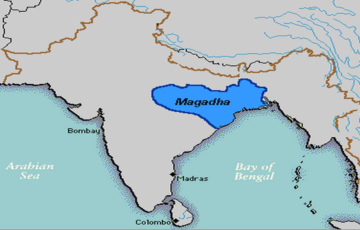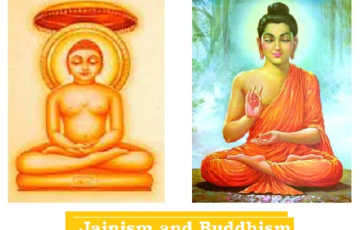EARLY HISTORY
History can be categorized into three distinct phases: Prehistory, Proto-history, and History.
- Prehistory encompasses events predating the invention of writing, often represented by the three Stone Ages. The Indian Stone Age is divided into three main categories. These are:
- Old Stone Age, or Palaeolithic Age
- Late Stone Age, or Mesolithic Age
- New Stone Age, or Neolithic Age
- Proto-history denotes the intermediate period between prehistory and recorded history, where the knowledge of writing exists, but deciphering the scripts remains a challenge.
- Despite the undeciphered Harappan script, the civilization is referenced in Mesopotamian writings.
- Similarly, the Vedic civilization (1500–600 BC) relied on an oral literary tradition.
In contrast, History constitutes the examination of the past after the advent of writing, involving the study of societies through written and archaeological sources.
Sources to Study Ancient History
- The archaeological sites and material culture including pottery, plant remains and metal objects.
- The Vedic literature (transmitted orally since no written documents for this period)
PALAEOLITHIC AGE (APPROX 3.3 MILLION YEARS TO 10,000 BC)
The Old Stone Age
- The term ‘Palaeolithic’ refers to the “Old Stone Age” marking the period from the first utilization of stone tools.
- It is difficult to estimate the beginnings of the Palaeolithic Age.
- It spans from the initial use of stone tools by Hominins, the immediate ancestors of Homo Sapiens, 3.3 million years ago, to the conclusion of the Pleistocene or Ice Age, approximately 11,650 years before the present.
- Human ancestors likely originated in Africa and subsequently migrated to various regions across the globe. The earliest human ancestor species to leave Africa was Homo erectus.
- Homo erectus, the migratory human ancestors, functioned as hunters and gatherers, residing in caves and rock shelters. Over time, they acquired the skill of using fire during this phase.
- Their toolkit comprised unpolished stones such as hand axes, cleavers, choppers, blades, burins, and scrapers.
- In India, they are also referred to as Quartzite men due to their use of quartzite for crafting tools.
- In India, human occupation, indicated by stone tools, began around 500,000 years ago during the Middle Pleistocene.
| Time Period | Discoveries and Events |
| 500,000 B.C | Early humans in South India and Soan Valley used crude stone tools for hunting and basic tasks. Paleolithic sites were found in Kashmir. |
| 100,000 B.C. | Stone tools found in Chotanagpur plateau. |
| 25,000 B.C. – 10,000 B.C. | Tools discovered in Kurnool district, Andhra Pradesh. |
| 25,000 B.C. | Domestication of goats, sheep, and cattle in Belan valley, Uttar Pradesh. |
| Earliest Paleolithic
8000 B.C. |
Humans relied on hunting and food gathering, with no agriculture or permanent housing.
● As mentioned in Puranas, some people continued living on roots and fruits in hills and caves |
Phases in the Palaeolithic Age
In India, It is divided into three phases according to the nature of the stone tools used by the people and also according to the nature of change in the climate.
Early or Lower Palaeolithic Age (20,00,000−60,000 BC)
- Lifestyle
- Early humans in this era adopted a nomadic lifestyle, relying on hunting and2 gathering for sustenance. They consumed animal flesh and bones from animals killed by predators.
- Fossils of various prehistoric animals, including Elephas namadicus and Stegodon Ganesa, were found in the Narmada valley.
- The Attirampakkam site yielded Equus teeth, Water Buffalo and Nilgai evidence, along with 17 animal hoof prints.
- Homo erectus inhabited river valleys, residing in caves and rock shelters, as evidenced by sites like Bhimbetka and Gudiyam.
- Homo Erectus lacked a complex language culture like Homo Sapiens, possibly expressing a few sounds or words and using sign language.
- Characteristics
- Robert Bruce Foote identified the first Palaeolithic tools at Pallavaram near Chennai in 1863.
- Stone tools were used mainly for chopping. Hand axes in the Strata contemporary with the second Himalayan glaciation. The climate became less humid.
- Tools, including hand axes and cleavers, exhibited physical symmetry, showcasing high cognitive skills of prehistoric humans.
- Acheulian and Sohanian cultures denote two distinct prehistoric technological traditions in the Early Palaeolithic Age.
- Sohan tradition, limited to northwestern areas, utilized choppers and chopping tools, named after the Sohan river valley in Pakistan.
- Acheulian tradition, prevalent in Central and southeast India, employed hand axes and cleavers, with notable absence in Western Ghats, coastal areas, and northeastern India due to heavy rainfall.
- Similar to tools in Western Asia, Europe, and Africa.
- Locations in India
- River Soan valley in Punjab (now in Pakistan),
- Belan valley in Mirzapur district in Uttar Pradesh
- Athirampakkam, Pallavaram and Gudiyam near Chennai
- Hunsgi Valley and Isampur in Karnataka
- Bhimbetka in Madhya Pradesh.
Middle Palaeolithic Age (3,85,000– 40,000 BC)
- Lifestyle
- In this phase, lithic technology underwent changes, and human ancestor species diverged due to behavioral modernity.
- D. Sankalia first identified this phase on the Pravara River at Nevasa in Maharashtra, India.
- Human ancestors adopted a hunter-gatherer lifestyle, dwelling in open-air spaces, caves, and rock shelter sites.
- The African Middle Stone Age is linked to Homo sapiens, while in Europe, it is associated with Neanderthals.
- No hominin fossil bone evidence has been discovered in India during this period.
- Neanderthals, an archaic human species closely related to modern humans, inhabited Eurasia from around 400,000 to 40,000 years ago.
- Characteristics
- Based on flakes, with regional variations.
- Principal tools are scrapers(made of flakes), borers, and blade-like tools.
- Tools underwent a size reduction, with a decline in the prevalence of hand axes compared to other tool types.
- Materials like chert, jasper, chalcedony, and quartz were utilized in the crafting of tools.
- Crude pebble industry in strata contemporary with the third Himalayan glaciation.
- Locations in India
- Soan Valley, Narmada River region, Godavari, Krishna, and Yamuna areas, areas south of the Tungabhadra River.
Upper Palaeolithic Age (40,000 − 10,000 BC)
- Lifestyle
- Modern humans emerged in Africa approximately 300,000 years ago, migrated to Asia around 60,000 years ago, potentially introducing the Upper Palaeolithic culture in India.
- This era is characterized by advancements in tool technology and increased cognitive capabilities, with people utilizing both caves and open-air spaces for habitation.
- Artistic evidence, including paintings, beads, and ornaments like the Green color paintings at Bhimbetka, indicates the cultural richness of this period.
- Discoveries such as incised ostrich eggshells, shell, and stone beads at Jwalapuram in Andhra Pradesh and Patne in Maharashtra highlight the material culture of this time.
- Characteristics
- Coincided with the last phase of the Ice Age around 8000 BC, with a comparatively warm climate. Very less humid phase
- At world level, the appearance of new flint industries and modern-type humans.
- In India, Use of blades and burins, Caves and rockshelters, Flakes and Scrapers.
- Kurnool caves in Andhra Pradesh have yielded bone tools and faunal remains.
- Locations in India
- The earliest evidence of a shrine in India is discovered at Baghor, Uttar Pradesh, from the Upper Palaeolithic period.
- Identified by a sandstone block enclosed by a rubble circle, resembling contemporary shrine structures.
- Meralbhavi in Karnataka, Kurnool caves in Andhra Pradesh, and Godavarikhani in Telangana.
- Patne in Maharashtra, Bhopal, Chotanagpur Plateau, and Bhimbetka are notable archaeological sites.
- Andhra, Karnataka, Gujarat dunes.
- The earliest evidence of a shrine in India is discovered at Baghor, Uttar Pradesh, from the Upper Palaeolithic period.
It would thus appear that the paleolithic sites are found in practically all parts of the country except the alluvial plains of the Indus and the Ganga.
THE LATE STONE AGE OR MESOLITHIC AGE
- From 8000 B.C. began an intermediate stage, which is called the Mesolithic Age, and continued up to about 4000 BC.
- It is a transitional phase between the Palaeolithic Age and the Neolithic or New Stone Age
- The Mesolithic culture’s chronological placement varies globally, with specific regions, such as the Levant in the Eastern Mediterranean, dating it between 20,000 and 9500 BC, assigned to pre-agricultural periods.
- Characteristics
- Climate:
- Following the Ice Age, as global warming occurred, human groups became increasingly mobile, occupying diverse ecozones.
- A monsoon pattern emerged, resulting in higher rainfall in certain regions. Notably, freshwater lakes were identified in Didwana, western Rajasthan.
- Analysis of animal bones from this era indicates the presence of a dry, deciduous type of forest during the Mesolithic period.
- Lifestyle: Mesolithic communities primarily engaged in subsistence hunting and gathering.
- Agriculture was not initially practiced, but towards the end of the Mesolithic period, humans began domesticating plants and animals, marking the transition to the Neolithic way of life.
- Fire was utilized, potentially for roasting food.
- Domestic animal bones, including cattle, sheep, goats, pigs, and dogs, were discovered at Kanewal, Loteshwar, and Ratanpur in Gujarat, as well as Adamgarh and Bhimbetka in Madhya Pradesh.
- Camel bones were unearthed at Kanewal.
- Mesolithic people were highly mobile, moving in search of animals and plant food. They constructed temporary huts and utilized caves and rock shelters for shelter.
- Traces of oval and circular huts, along with potential wattle daub, were identified in Chopani Mando and Damdama (Uttar Pradesh) and Tilwara (Rajasthan).
- Tools: Microlithic tools were utilized to adapt to changes in flora and fauna, facilitating the hunting of smaller animals and birds.
- Art and culture:
- A chert stone with geometric engravings was discovered in Chandravati in Rajasthan, while bone objects and a human tooth engraved with geometric designs were found in
- Rock paintings depicting hunting, trapping, fishing, and dancing are present in rock shelters in Madhya Pradesh and Central India.
- Sites like Bhimbetka near Bhopal, Raisen, Pachmarhi in Madhya Pradesh, and South Mirzapur in Uttar Pradesh exhibit evidence of artistic expressions.
- Bhimbetka paintings illustrate collaborative hunting efforts by both men and women, showcasing various hunted animals.
- Burials: The practice of burying the dead indicates underlying beliefs.
- Human skeletons were discovered in Mahadaha, Damdama, and Sarai Nahar Rai in Uttar Pradesh.
- At Mahadaha, a burial site contained the remains of a man and a woman interred together.
- The deceased were buried with grave goods, with one burial featuring an ivory pendant as a significant item.
- Sites across India: Mesolithic sites are distributed across diverse eco-zones in India, ranging from coastlines to mountains.
- Notable sites include Paisra (Bihar), Langhnaj (Gujarat), Baghor II, Chopani Mando, Sarai Nahar Rai, Mahadaha, and Damdama (all in Uttar Pradesh), as well as Sankanakallu and Kibbanahalli (Karnataka).
- Rock shelter sites can be found in Lekhakia and Baghai Khor (Uttar Pradesh), and Adamgarh and Bhimbetka (Madhya Pradesh).
- Coastal locations include Mumbai, teri sites (formed by sand dunes) in Thoothukudy, Tamil Nadu, and
- On the northern spurs of the Vindhyas in the Belan Valley all the three phases of the Palaeolithic followed by the Mesolithic and then by the Neolithic have been found in sequence.
- Human skeletons were discovered in Mahadaha, Damdama, and Sarai Nahar Rai in Uttar Pradesh.
- Climate:
THE NEW STONE AGE OR NEOLITHIC AGE
- The Neolithic period signifying the onset of agriculture and animal domestication.
- At world level, the New Stone Age began in 7000 B.C., whereas neolithic settlements in the Indian sub-continent are not older than 6000 B.C.
- Some settlements found in south India and eastern India are as late as 1000 B.C..
- The Neolithic phase spanned approximately 2500 B.C. to 1000 B.C., with the earliest scientifically dated site at Utnur, Telangana from 2300 B.C.
- Early evidence of Neolithic culture is evident in fertile regions such as Egypt and Mesopotamia, the Indus region, the Ganges valley in India, and China.
- Characteristic tools: Polished stone, stone axes, microlith blades
| Areas | Characteristics |
| Valley of Kashmir (e.g., Burzahom) | ● No agriculture or domestication of animals.
● Dwellings were pit structures, oval-shaped, wider at the bottom, and narrow at the top, serving as protection against cold weather. ● Utilization of bone and stone tools, presence of menhirs (standing stones), and the use of redware pottery and metal objects, including copper arrowheads, were observed. ● Agricultural practices and animal domestication were common. Excavations revealed seeds of wheat, barley, common pea, and lentils, indicating contact with Central Asia. ● The Burzahom people were contemporaneous with the Harappa civilization and engaged in trade with them. ● Two phases of Neolithic culture were identified: aceramic and ceramic. ○ The aceramic phase lacked pottery evidence, while the ceramic phase exhibited pottery, including black ware, agate and carnelian beads, and painted pottery. ● A burial site unearthed wild dog bone and antler horn, with a stone depicting an engraving of a hunting scene featuring a dog and the sun. ○ Burials included domestic dogs buried with masters. |
| Ganges Valley and Central India | ● Lehuradeva, Chopani Munda, Koldiwa, and Mahagara in Uttar Pradesh, along with Chirand and Senuwar in Bihar, are significant Neolithic sites.
● Lehuradeva, specifically, has provided early evidence of rice cultivation dating back to 6500 BC. ● These sites exhibit evidence of pottery, as well as the domestication of plants and animals, characterized by cord-marked pottery. ● Cultivation evidence includes hulled and six-rowed barley, various types of wheat, rice, pea, green gram, gram/chickpea, mustard, flax/linseed, and jackfruit. ● Animal remains, including sheep, goat, and cattle bones, alongside bones of wild animals, have also been discovered at these sites. |
| Northwest India | ● Dating back to 7000 BC
● Cultivation of wheat and barley and the domestication of sheep, goats, and cattle. ○ This culture predates the Indus Civilization. ● In the first cultural phase (7000-5500 BC) of Mehrgarh, crops like six-row barley, emmer and einkorn wheat, jujube, ilanthai, and dates were cultivated. ○ The people were semi-nomadic pastoral groups, constructing houses with mud and practicing burial of the dead. ■ They used sea shells, limestone, turquoise, lapis lazuli, and sandstone for ornamentation. ● The second cultural phase (5500-4800 BC) and third phase (4800-3500 BC) involved long-distance trade, as evidenced by the presence of Lapis Lazuli from Badakshan. ○ Pottery emerged during these periods, along with the discovery of terracotta figurines and glazed faience beads. ● Early dentistry practices are observed, where the consumption of ground grain and cooked food led to dental issues. ○ The earliest evidence of drilling a human tooth (of a living person) was found at Mehrgarh, considered a precursor to dentistry. ● Major Sites are Mehrgarh, Rana Ghundai, Sarai Kala and Jalilpur. (most are in Pakistan) |
| South India (south of Godavari River) | ● Tools used: Stone axes and stone blades used.
● Fire-baked earthen figurines suggesting cattle keeping. ● Possessed cattle, sheep, and goats. ● Familiarity with grinding grains using rubbing stone querns. ● Sites exhibit ash mounds at the center, with settlements surrounding them. ○ Examples include Utnur and Palvoy in Andhra Pradesh, as well as Kodekal, Kupgal, and Budihal in Karnataka. ● Typically situated near granite hills with water sources, these sites are found in the river valleys of Godavari, Krishna, Pennaru, Tungabhadra, and Kaveri. ● Major sites include: ○ Karnataka: Sanganakallu, Tekkalakota, Brahmagiri, Maski, Piklihal, Watkal, Hemmige, and Hallur. ○ Andhra Pradesh: Nagarjunakonda, Ramapuram, and Veerapuram. ○ Tamil Nadu: Paiyyampalli. |
| Assam and Garo Hills | ● The culture, dating from 2500-1500 BC, is characterized by tools like shouldered axes and splayed celts found in Assam, Meghalaya, Nagaland, and Arunachal Pradesh.
● Important sites such as Daojali Hading and Sarutaru provide evidence of shifting cultivation. ● Distinctive features in this region include the cultivation of yams and taro, the construction of stone and wooden memorials for the deceased, and the presence of Austro-Asiatic languages. |
| East India | ● Neolithic sites are prevalent in Bihar and West Bengal, with notable locations including Birbhanpur, Kuchai, Golbaisasan, and Sankarjang.
● Tools discovered at these sites include pointed butts, celts, chisels, and shouldered axes. |
- Rice cultivation in the sixth millennium BC was found in northern Vindhya spurs, Mirzapur, Allahabad, and Balochistan, suggesting ancient agriculture.
- Notable Neolithic sites include Maski, Brahmagiri, Hallur, Kodokal, Sanganakallu, T. Narsipur and Takkalakota in Karnataka, and Paiyampalli in Tamil Nadu; Piklihal in Andhra Pradesh and Utnur in Telangana.
- Piklihal’s early Neolithic settlers were cattle herders. They domesticated cattle, sheep, goats, etc. Both ash mounds and habitation sites have been discovered in Piklihal.
- The later neolithic settlers were agriculturists, who lived in circular or rectangular houses made of mud and reed. In any case these neolithic people led a settled life.
- Agricultural produce: Ragi and horsegram (kulathi).
- Hand-made pottery is found in the early stage. Later they used foot wheels to turn up pots.
- In the Orissa hill areas, Neolithic celts have been found, and rice cultivation and small-scale settlements began in this part of the country quite early.
- Western Asia experienced significant technological progress from 9000 B.C. to 3000 B.C., paralleling crop cultivation in the Indian subcontinent.
- Dependency of Stone tools limits the settlements to hilly river valleys.
- Further, even with great effort they could not produce more than what they needed for their bare subsistence.
CHALCOLITHIC PERIOD
Towards the end of the neolithic period began the use of metals. Copper was the first metal used. Numerous objects made of copper where raw copper is locally available. Cultures combining stone and copper tools are called Chalcolithic.
- Tools:
- Used small tools and weapons, stone axes, and the stone blade industry These tools continued till they were ultimately replaced by iron tools.
- Used copper objects such as flat axes, bangles, rings, antimony rods, knives, blades, socket-less axes, barbed and tanged arrowheads, choppers and chisels.
| Settlements | Locations and Key Characteristics |
| South-eastern Rajasthan | Dry regions of Banas Valley
● Ahar (Absence of stone axes or blades) ● Gilund (Stone-blade industry) ● Ganeshwar primarily supplied copper objects to Harappa during ancient times. ● The community’s subsistence relied heavily on a combination of hunting and agriculture. |
| Western Madhya Pradesh | ● In Malwa: Kayatha & Eran
● Navdatoli on Narmada |
| Uttar Pradesh | Proximity to the Vindhyas, multiple sites (Allahabad region) |
| Western Maharashtra | ● Jorwe (Flat, rectangular copper axes)
● Nevasa – Daimabad (Ahmadnagar district) ● Chandoli (Copper chisels) ● Songaon – Inamgaon (Pune district) ● Nasik |
| Eastern India | ● Chirand on the Ganga
● Pandu Rajar Dhibi (Burdwan district), Mahishdal (Midnapore district) in West Bengal |
| Andhra Pradesh | ● Some elements found in neolithic sites, but copper objects absent
● Important sites are Kodekal, Utnur, Nagatjunikonda, and Palavoy |
The following Chalcolithic sites are region-wise:
- INDUS SYSTEM: Mohenjo-daro, Harappa, Ropar, Suratgarh, Hanumangarh, Chanhu-daro, Jhukar, Amri, Jhungar
- GANGES SYSTEM: Kausambi, Alamgirpur
- BRAHMAPUTRA SYSTEM
- MAHANADI SYSTEM
- CHAMBAL SYSTEM: Pseva, Nagda, Paramar-Khers, Tungni, Metwa, Takraoda, Bhusuri, Betwa, Bilawal, Ghata-Bilod, Ashta
- RAJPUTANA-SAURASHTRA: Rangpur, Ahar, Prashas Patan, Lakhabawal, Lothal, Pithadia, Rojdi, Adkot
- NARMADA SYSTEM: Navdatoli, Maheshwar, Bhagatrav, Telod, Mehgam, Hasanpur
- TAPI SYSTEM: Prakash, Bahal
- GODAVARI-PRAVARA SYSTEM: Jorwe, Nasik, Kopargaon, Nevasa, Daimabad
- BHIMA SYSTEM: Koregaon, Chandoli, Limbraj, Chanegaon, Nagarballi, Anachi, Hingni
- KARNATAKA: Brahmagiri, Piklihal, Maski
Chalcolithic Culture
Pottery:
- Mainly Black-and-red pottery, wheel based, painted with white linear designs.
- People living in Madhya Pradesh and Maharashtra produced channel-spouted pots, dishes-on-stand and bowls-on-stand.
- In many parts of the country the black-and-red pottery continued till the second century B.C.
- Ochre Coloured Pottery Ware culture (2600-1200 BC) is located in northern India within the Indo-Gangetic plain during the Chalcolithic period.
- The culture is recognized as the “copper hoard culture” due to the production of copper figures and objects at its sites.
- It is characterized as a rural culture with evidence of agriculture and animal rearing.
- Villages associated with this culture featured wattle-and-daub houses.
- Copper and terracotta ornaments were utilized, and animal figurines were also discovered.
| Domestication of Animals and Food Grains:
The people living in the stone-copper age in south-eastern Rajasthan, western Madhya Pradesh and western Maharashtra domesticated animals and cultivated foodgrains. ● Animals: ○ They kept cows, sheep, goats, pigs and buffaloes, and hunted deer. ○ Remains of the camel have also been found. ○ It is not clear whether they were acquainted with the horse. ○ People certainly ate beef, but they did not take pork on any considerable scale. ● Food grains ○ Regional differences in regard to cereals, structures, pottery, etc. ○ People produced wheat, rice, bajra, and pulses such as the lentil (masur), black gram, green gram, and glass pea. ○ Their cereal food was supplemented by non-vegetarian food ○ Eastern India produced rice; western India cultivated barley and wheat. ○ The people of Navdatoli produced all the above and also produced ber and linseed. ■ Cotton was produced in the black cotton soil of the Deccan, and ragi, bajra and several millets were cultivated in the lower Deccan. ○ In eastern India fish hooks have been found in Bihar and West Bengal |
Houses:
- Burnt bricks were not used; construction featured mud bricks, wattle and daub, and thatched houses.
- In an earlier Chalcolithic phase at Inamgaon, large mud houses with ovens and circular pit houses were discovered. The later phase (1300-1000 B.C) showed family-sized houses like one with five rooms, signifying larger families.
- The Jorwe culture marked stable and widespread settlements, each nucleated with over 35 houses of varying shapes.
- Some settlements like Inamgaon, Eran, and Kayatha had fortifications and moats, but urban civilization was absent.
Arts and crafts:
- Proficient copper smiths with skill in stone work.
- Produced numerous microliths, very small stone tools.
- Demonstrated knowledge of spinning and weaving, evidenced by spindle whorls in Malwa and discovery of cotton, flax, and silk threads in Maharashtra.
- Displayed expertise in cloth manufacturing.
Burial Practices:
- In Maharashtra, burials occurred under house floors, positioned north to south whereas In south India the position is east- west.
- Almost complete or extended burial obtained in Maharashtra, but post-extraction or fractional burial prevailed in West Bengal
- Burials are distinct from Harappans, who had separate cemeteries.
- Graves included pots and copper items for the deceased’s use in the afterlife.
Religious Worship
- Terracotta female figurines indicate the Chalcolithic people’s reverence for the mother goddess. Inamgaon yielded a mother goddess figure similar to Western Asia.
- Unbaked nude clay figurines were employed for worship.
- Stylized bull terracottas in Malwa and Rajasthan symbolized a religious cult.
Society
- The stone-copper phase marked the emergence of social inequalities.
- Graves at Chandoli and Nevasa in western Maharashtra revealed differences in burial goods for children, with some receiving copper-bead necklaces and others only pots.
- Inamgaon saw an adult burial with pottery and copper.
- Kayatha unearthed 29 copper bangles and distinctive axes, along with semi-precious stone necklaces, indicating affluence among certain individuals.
| Importance of the Chalcolithic Phase | Limitations of Chalcolithic Cultures |
| ● Proficiency in copper smelting was common among them.
● Innovators of painted pottery for cooking, eating, and storage purposes. ● Usage of “lota” observed, but no evidence of the “thali.” ● In south India, a seamless transition from Neolithic to Chalcolithic cultures is noted, termed “Neolithic-Chalcolithic.” ● Western Maharashtra, Rajasthan, and West Bengal saw Chalcolithic people potentially as colonizers, with settlements emerging in various regions like in Kayatha and Eran |
● Chalcolithic social and economic pattern did not promote longevity.
● High infant mortality observed in western Maharashtra during the chalcolithic period, possibly due to factors like malnutrition, lack of medical knowledge, or epidemics, despite a food-producing economy. ● The Chalcolithic culture was predominantly rural with limited copper supply and pliant copper tools; bronze-making, essential for advanced civilizations, was unknown. ● Absence of writing and urban centers distinguished the Chalcolithic Age from Bronze Age. ● Elements of civilization and advanced technology first appeared in the Indus region, but other Chalcolithic Age cultures in India didn’t significantly benefit from this knowledge. |
IRON AGE
A circular tomb using big stone slabs built upon the place of burial is known as a megalith.
| Aspect | Iron Age in North India | Iron Age in Tamilnadu / Megalithic |
| Time Period | 1100 to 800 BCE | Continuation of Neolithic burial practices into the Megalithic period. |
| Pottery | Painted Grey Ware pottery, primarily in Ganga-Yamuna valley. | Presence of black-ware pottery, mainly in burial mounds in Tamil Nadu. |
| Pottery Features | Fine grey color with painted geometric designs, influencing early political formations. | Black-ware pottery not found in human habitations. |
| Transition | Succeeded Black and Red Ware Culture in eastern Ganga valley and Central India. | Another type of burial- Urn burial system, is evidenced in Adichanallur. |
| Historical Correlation | Correlated with the Kuru-Panchala kingdom from Vedic texts. | Urn burials are categorized Megalithic because they share materials (pottery, iron items, semi-precious stone beads) with stone burials. |
| Subsequent Culture | Followed by Northern Black Polished Ware culture, associated with Mahajanapada and Mauryan periods. | End of Megalithic burial practices around the 2nd-3rd centuries CE. |
| Social and Economic Development | Reflects agricultural and pastoral development, leading to growing settlements and a significant population increase in northern India. | Brahmi writing similar to Ashokan Brahmi discovered in Kodumanal, Erode District. |
| Coincided with | Megalithic burial mounds of south India | Megalithic burial mounds, menhirs, monumental stones, and dolmens in Tamilnadu. |
MEGALITHIC SITES IN TAMILNADU
- Vadamalkunda in Krishnagiri district: uncovered Black and red ware, along with partial human remains and iron objects. A few stone slabs were also found at the site.
- Singaripalayam near Kundadam, Tiruppur district: An ancient settlement along the River Uppar was indicated by a centuries-old menhir unearthed in.
- Mallachandram: Dolmen was found
- Kumarikalpalayam- Tirupur: Menhir was found
- Puliman Kombai: Tamil Brahmi inscription on a hero stone
- Adichanallur: Urns and pottery; Iron implements, including spades and weapons (daggers, swords, spears and arrows); stone beads and gold ornaments; Bronze objects representing the domestic animals such as buffalo, goat or sheep and cock, and wild animals like tiger, antelope and elephant; Traces of cloth and wood; The presence of husks of rice and millet indicates domestication of these grains
- Paiyampalli in Tirupathur taluk, Vellore district: Black and red ware pottery; Urn burials; dated 1000 BCE as per radiocarbon dating analysis.
- Kodumanal (2nd century BCE to 2nd century CE): pots, weapons, tools, ornaments, and beads, particularly carnelian, similar to those found at Mohenjodaro
- Sangam text “Pathitrupathu” praised Kodumanal for gemstones.
- Roman coin hoards hint at gemstone exports to Rome.
- Discoveries: Conches, bangles, furnace remnants, kiln floor with ash soot, and Tamil-Brahmi inscribed potsherds.
- Burial Practices: Pit burials, urn burials, and various chamber tombs.
- Potsherds with inscribed names suggest multi-ethnic habitation.
IMPORTANT FACTS RELATED TO THE CHAPTER
○ These structures had roofs made of hay, branches, and leaves, supported by massive wooden posts at regular intervals. ○ Excavations were conducted by Mr. H.D. Sankalia, a professor at Deccan College, Pune.
|
UPSC PREVIOUS YEAR QUESTION
1. Consider the following pairs: [UPSC CSE 2021]
(Historical place) (Well-known for)
1) Burzahom : Rock-cut shrines
2) Chandraketugarh : Terracotta art
3) Ganeshwar : Copper artefact
Which of the pairs given above is/are correctly matched?
a) 1 only
b) 1 and 2
c) 3 only
d) 2 and 3
Answers: d

